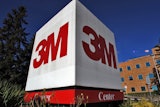Tuesday marked the 70th anniversary of the Allied liberation of Auschwitz — and the world’s eyes turned to the famed camp to remember the horrors, and honor the remaining survivors.
How much do you know about the infamous chemical company that played a pivotal role in Auschwitz’s history? Take a read and find out.
Ariel photos of an IG Farben chemical plant captured early images of Auschwitz: Throughout 1944, Allied reconnaissance planes set out to capture photos of an IG Farben chemical plant in Poland, where it was believed that the Nazis were producing synthetic oil. (Oil fields and refineries were being lost to Germany in Europe — and because oil production for Germany’s war machine was crucial, the Allies were planning to attack Germany’s fuel industry.) By accident, the aircrafts captured photos of another complex nearby — which turned out to be Auschwitz. Some photos showed trains arriving and guards shuffling prisoners around the complex. But the photos weren’t analyzed — some weren’t even developed until the 1970s — and Auschwitz wasn’t liberated by Red Army soldiers until the following year.
IG Farben, which was put on trial for war crimes, was the largest chemical company in the world: IG Farben was a mega-conglomerate of several firms. Its IG Auschwitz plant was designed to be the first complex chemical factory that, in addition to fuels, produced various plastics, synthetic rubber, fibers, stabilizing agents, resins, methanol and pharmaceuticals. After the war, the Soviet Union seized IG Farben’s assets, and the Western Allies split it up into its original companies, two of which — Bayer and BASF — went on to be some of the most biggest and most successful chemical companies in the world.
IG Farben’s most notorious patented chemical — Zyklon-B — was developed to be a pesticide to kill vermin: Some historians say that Hitler wasn’t eager to use chemical weapons — except for at Auschwitz. Developed as a cyanide-pesticide, Zyklon-B consisted of hydrogen cyanide, which interferes with cellular respiration. Zyklon-B was the chemical used in gas chambers and is estimated to have killed roughly a million people. IG Farben also discovered sarin, a potent nerve agent that has been classified as a weapon of mass destruction.
IG Farben scientists also made positive contributions to the world of chemistry: Several IG Farben scientists were given Nobel Prizes in the 1930s and in 1950. Among the note-worthy contributions was the invention and development of chemical high-pressure methods and discovering the antibacterial effects of prontosil.
Learn more about the scale of Auschwitz and see how IG Farben's factory fit into the layout of the camp in this CNN video:























